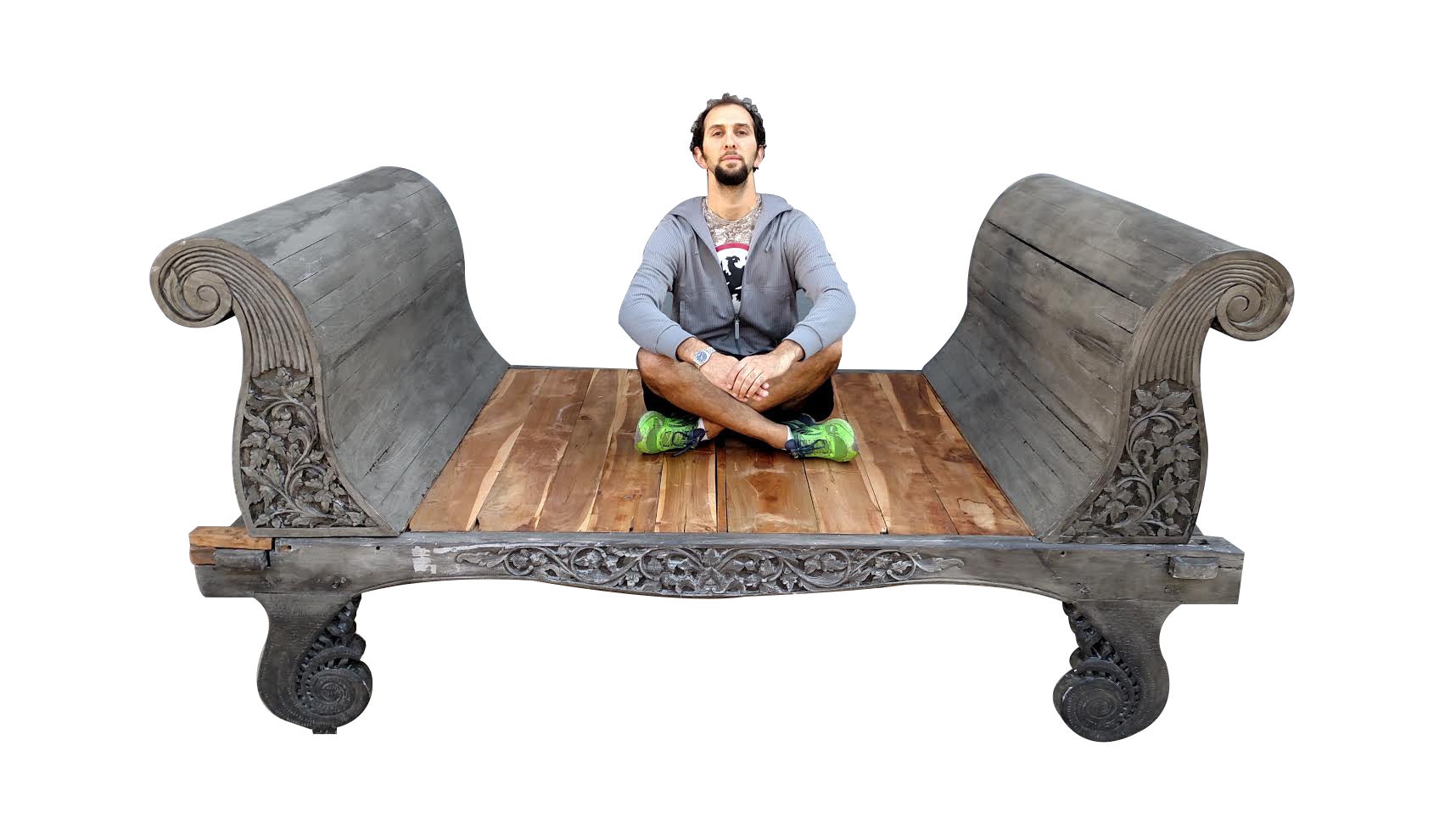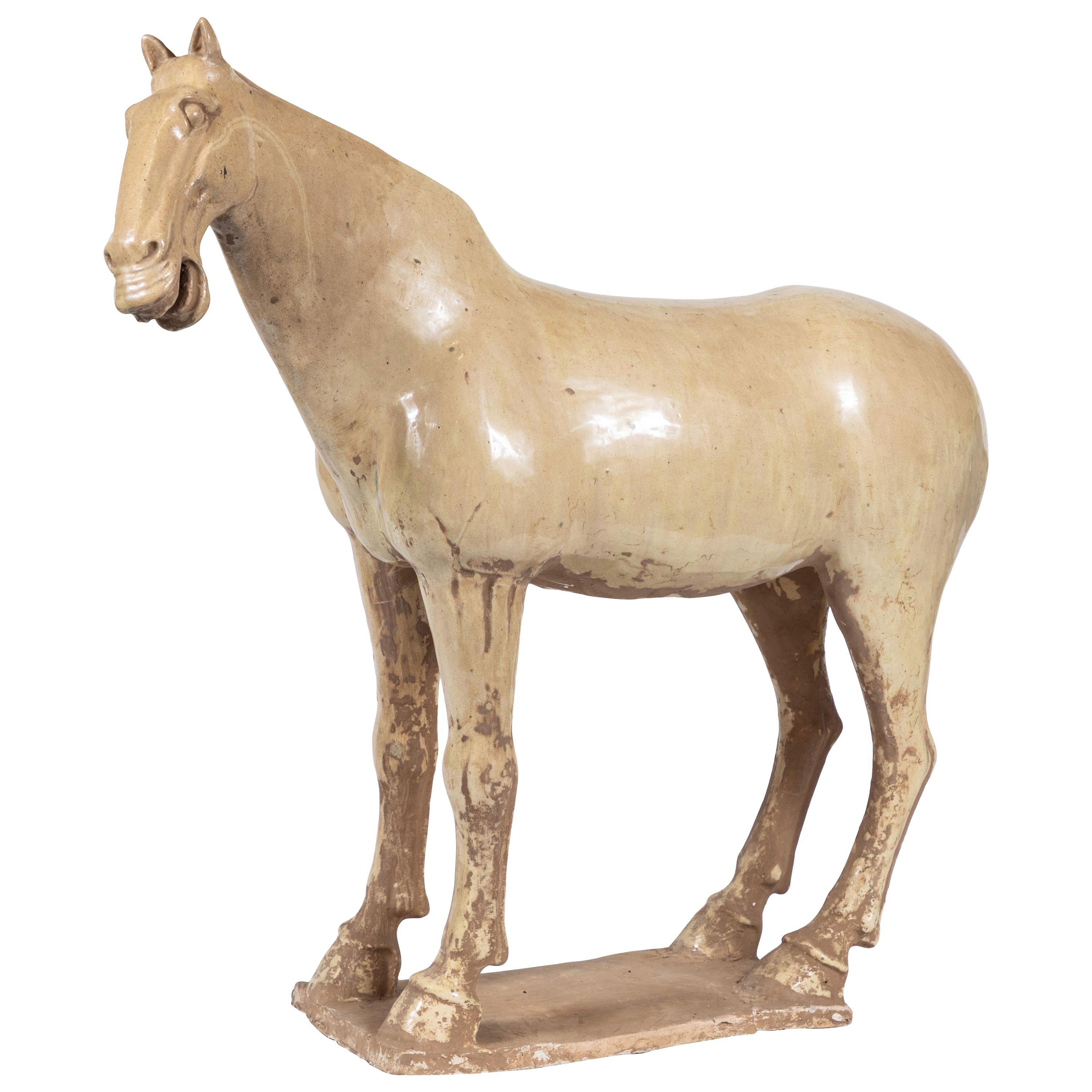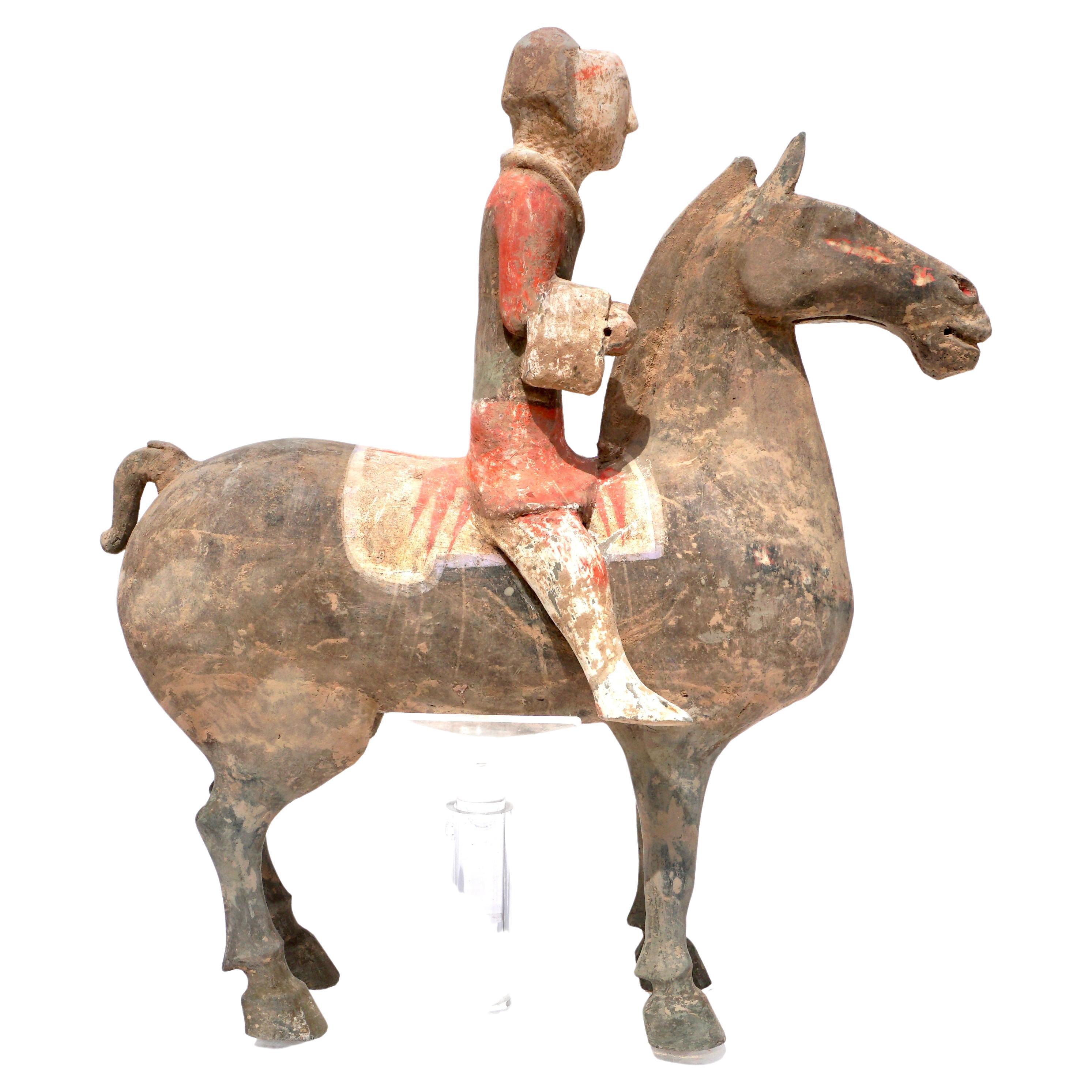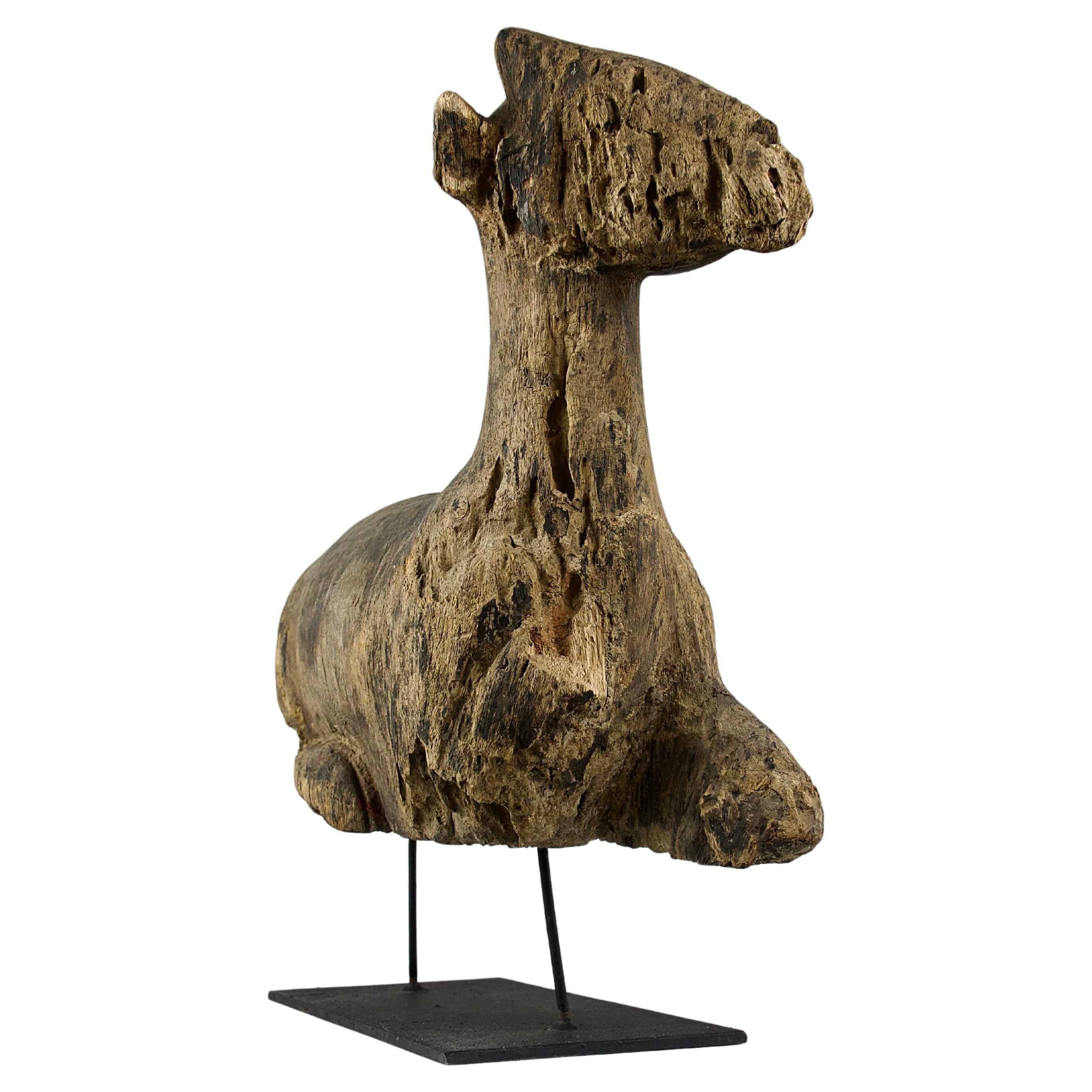Items Similar to Vintage Han Dynasty Style Cast Iron Horse Sculpture on Wood Base 21"
Want more images or videos?
Request additional images or videos from the seller
1 of 13
Vintage Han Dynasty Style Cast Iron Horse Sculpture on Wood Base 21"
About the Item
20th century cast iron sculpture or hitching post of a Han (or Tang) Dynasty style horse with muscular cheeks, open mouth and no legs. Mounted on a hollow, dovetailed, un-finished wood base.
Dimensions:
20.75" x 9.5" x 17.25" (Width x Depth x Height)
- Dimensions:Height: 17.25 in (43.82 cm)Width: 20.75 in (52.71 cm)Depth: 9.5 in (24.13 cm)
- Style:Han (In the Style Of)
- Materials and Techniques:
- Period:
- Date of Manufacture:20th Century
- Condition:Wear consistent with age and use. Good Overall - Some flaking of rusted finish; gentle wear to base.
- Seller Location:Dayton, OH
- Reference Number:

About the Seller
4.9
Platinum Seller
These expertly vetted sellers are 1stDibs' most experienced sellers and are rated highest by our customers.
Established in 2010
1stDibs seller since 2020
1,113 sales on 1stDibs
Typical response time: <1 hour
- ShippingRetrieving quote...Ships From: Dayton, OH
- Return PolicyA return for this item may be initiated within 2 days of delivery.
More From This SellerView All
- Vintage Heavy Cast Iron Equestrian Horse Head Hitching Post BM-015 9"Located in Dayton, OHVintage heavy cast iron horse head hitching post. Marked BM-015. Dimensions: 7.25” x 4” x 9.25” (Width x Depth x Height)Category
Mid-20th Century American Country Mounted Objects
MaterialsIron
- Josep Maria Subirachs Industrial Modernist Abstract Cast Iron SculptureBy Josep Maria Subirachs SitjaLocated in Dayton, OHAn Impressive Cast Iron floor sculpture by Josep Maria Subirachs, circa 1960s. Reminiscent in form to an arrowhead or primitive blade. Josep incorporated grattage leaving the surface rough and jagged. Signed along the lower edge. From the private collection of Vincent and Elana Bolling. The Bollings were philanthropists and advocates for the performing and visual arts. JOSEP MARIA SUBIRACHS SITJAR was born on March 11, 1927 in Barcelona. From the age of nine to the age of twelve he experienced the tragic events of the Spanish Civil War, the overthrow of the Republican government in 1939 and the beginning of the Franco regime. Born into a working class family in the Barcelona district of Poblenou, the precarious economic situation suffered during the post-war period forced him to renounce studying architecture and he began working at the workshop of a gilder and amateur sculptor when he was just fourteen years old. By then, he was already modeling clay figures which he used to bring to the furnace at a local roof tile factory. From 1942 to 1947 he worked as an apprentice under the sculptor Enric Monjo at his workshop, acquiring technical skills. But the person who taught him most profoundly was Enric Casanovas, with whom he worked for a brief period because, unfortunately, the 'Noucentista' died in January 1948, just a fews months after Subirachs entered his workshop as a collaborator.The influence of Casanovas is apparent in the young sculptor...Category
Mid-20th Century Spanish Industrial Abstract Sculptures
MaterialsIron
- Josep Maria Subirachs Industrial Modernist Abstract Cast Iron Wall SculptureBy Josep Maria Subirachs SitjaLocated in Dayton, OHAn Impressive Cast Iron wall hanging sculpture by Josep Maria Subirachs, circa 1960s. Reminiscent in form to an arrowhead or primitive blade. Josep incorporated grattage leaving the surface rough and jagged. Signed along lower edge. From the private collection of Vincent and Elana Bolling. The Bollings were philanthropists and advocates for the performing and visual arts. Measure: 34". JOSEP MARIA SUBIRACHS SITJAR was born on March 11, 1927 in Barcelona. From the age of nine to the age of twelve he experienced the tragic events of the Spanish Civil War, the overthrow of the Republican government in 1939 and the beginning of the Franco regime. Born into a working class family in the Barcelona district of Poblenou, the precarious economic situation suffered during the post-war period forced him to renounce studying architecture and he began working at the workshop of a gilder and amateur sculptor when he was just fourteen years old. By then, he was already modeling clay figures which he used to bring to the furnace at a local roof tile factory. From 1942 to 1947 he worked as an apprentice under the sculptor Enric Monjo at his workshop, acquiring technical skills. But the person who taught him most profoundly was Enric Casanovas, with whom he worked for a brief period because, unfortunately, the 'Noucentista' died in January 1948, just a fews months after Subirachs entered his workshop as a collaborator.The influence of Casanovas is apparent in the young sculptor...Category
Mid-20th Century Industrial Abstract Sculptures
MaterialsIron
- Antique Salin French Neoclassical Cast Iron Garden Sculpture Statue Cherub 34"By Salin Foundry, ParisLocated in Dayton, OH19th century salin foundry French neoclassical cast iron sculpture statue, France Features two boys playing Front of plinth inscribed Salin, France Salin Foundry, Dammarie-sur-S...Category
Antique 19th Century Renaissance Figurative Sculptures
MaterialsIron
- Nita Sunderland "Standing Woman" Cast Bronze Abstract Modern Sculpture 60"By Nita K. Sunderland 1Located in Dayton, OH"Standing Woman" by Nita Sunderland, Features an abstract form of a Standing women. Circa 1960s Mounts via iron pipe along base Nita K. Sunderland, 92, American sculptor, died July 17, 2020 at Generations at Riverview in East Peoria. Nita was born November 9, 1927, in Newton, Illinois, to parents Sarah (Taylor) Sunderland and Glenn H. Sunderland. She grew up in Newton, and continued her education in Norton, Mass, where she graduated from House in the Pines junior college in 1947. There she developed impressive equestrian skills and became captain of the school’s Riding Club. She briefly taught physical education at Lancaster Country Day School in Lancaster, PA, before resuming her education. She studied art at Duke University before transferring to Bradley University, where she received her BFA in 1952. Nita taught art at the University of Michoacan, Mexico, from 1953 to 1954. She received her Masters degree in ceramics from Bradley University in 1955 and joined the Bradley faculty a year later. As one of the first woman college sculpture instructors in the United States, Nita was constantly breaking the glass ceiling throughout her career. She taught sculpture, drawing, and 3-D design at Bradley until she retired as a Professor Emeritus in 1988. Nita is known for her mostly large-scale works of sculpture carved from Indiana limestone...Category
Vintage 1960s Modern Abstract Sculptures
MaterialsBronze
- Vintage Bronze Eagle on Altar Stick Sculpture Statue After Archibald Thorburn 17By Archibald ThorburnLocated in Dayton, OHAn impressive bronze eagle over an altar stick after Archibald Thorburn (Scottish 1860-1935). Features a bronze figure of a perched golden eagle. The eagle is in black with a gold be...Category
20th Century Animal Sculptures
MaterialsBronze
You May Also Like
- Vintage Midcentury Bronze Asian Style Horse Sculpture, Han Dynasty Flying HorseLocated in Miami, FLVintage midcentury Asian bronze horse sculpture, Han dynasty flying horse Offered for sale is a striking vintage midcentury bronze horse sculptur...Category
Mid-20th Century Animal Sculptures
MaterialsBronze
- Han Dynasty Horse Sculpture, 206BC- 209 ADLocated in Tunbridge Wells, GBHan Dynasty Horse Sculpture, 206BC- 209 AD It is interetsing to note the position of the riders feet. They are gripping the shoulder of the horse. D...Category
Antique 15th Century and Earlier Chinese Han Animal Sculptures
MaterialsPottery
- Large, Han-Style Horse SculptureLocated in Newport Beach, CAGrand, crème glazed terracotta, Han-style, braying stallion sculpture.Category
Vintage 1980s Chinese Han Animal Sculptures
MaterialsTerracotta
- Han Dynasty Pottery Horse and RiderLocated in Dallas, TXHan Dynasty painted pottery horse and rider A Chinese Han Dynasty painted pottery horse & rider. Made from grey pottery and cold-painted in white, red and black pigments. The rider dressed as a warrior and in the pose of holding reins for the horse. Comes with a custom sturdy lucite stand. Measures: Height: 13.5 inches (33cm). Length: 13 inches Depth: 5 inches Han Dynasty (206 BC – AD 220). Condition: Very good with past restoration to legs. The great influence of the horse throughout the history of China can...Category
Antique 15th Century and Earlier Chinese Han Animal Sculptures
MaterialsPottery
- Han Dynasty Polychromed Horse and RiderLocated in Dallas, TXA fine Han dynasty polychrome painted terracotta horse and rider. The warrior is dressed in orange and black on a black horse. Measures: Height 14 inches (35 cm) Width 12.5 inches (32 cm). Condition: Excellent with tastefully undetectable repairs. During the unification of China under the Han dynasty, bands of mounted nomadic warriors from the north threatened the country. In order to thwart their attacks, the Chinese sought to import stronger, faster steeds from Central Asia (as opposed to the Mongol ponies used by the invaders), eventually leading to the creation of the Silk Road. This small sculpture of a mounted soldier reveals the crucial military role of the horse. When compared to the diminutive stature of the rider, the importance of the horse becomes readily apparent. This creature provided security and strength, allowing the empire to secure its borders and expand its influences across Central Asia. The magnificent regalia of the horse, including a brilliantly painted saddle in red and green/gold, reflect the respect this animal received. The warrior as well is gorgeously decorated with a painted red tunic and gray chest...Category
Antique 15th Century and Earlier Chinese Han Figurative Sculptures
MaterialsTerracotta
- Han Dynasty, Laying Doe Wood Sculpture, China 100ADLocated in PARIS, FRSuperb sculpture of a laying doe from the Chinese Han Dynasty (206BC-220AD). Remainders of polychromic paint, namely red, symbol of good fortune and joy as well as the season of summer, and green, symbol of vigor and vitality and the season of spring. Mounted on base. Condition seen in pictures. Dimensions in cm ( H x L x l ) : - Sculpture : 35 x 40 x 10 - With base : 45.5 x 44 x 15 The Han Dynasty ruled China from 206 B.C. to 220 A.D. and was the second imperial dynasty of China. It is known for its promotion of Confucianism as the state religion and opening the Silk Road trade route to Europe, permanently altering the course of Chinese history. Han Dynasty art and inventions like paper still influence the world today. From the Han Dynasty to the present, deer can be found in many materials and media—rock crystal, nephrite, ink on paper, porcelain, cloisonné enamel, jade, bamboo root, textile, bronze, etc.—alone or in groups, among trees and rocks and in various positions. They appear on everyday objects, from boxes to incense burners, incense holders, lamps, mirror holders and the droppers scholars used when they wrote. A symbol of longevity and grace in Chinese mythology, the word deer is pronounced lu, a homonym for emoluments—favors granted to officials. They therefore represent wealth, nobility and success in imperial examinations (civil service exams for selecting candidates for the state bureaucracy in Imperial China). Deer were the faithful companions of Shu Lao, the god of longevity, and the goddess Magu. They were reputed to live long and to be the only creature able to find the mushroom of immortality, linghzhi. Although its spots are different, deer are sometimes confused or associated with stags, a Manchu hunting trophy whose antlers served to make prestigious furniture. (La Gazette Drouot, Claire Papon) For the colours found on this piece, in Chinese culture, red symbolizes good fortune and joy. Green, symbolizes the spring when everything is brimming over with vigor and vitality. The Han Dynasty (206 B.C. to 220 A.D.) continued the Qin Dynasty’s use of dark colours, but incorporated red. During the earlier years, or Western Han Dynasty, ordinary people wore red while court dress was black. Shoes were red in color. The clothing worn for sacrificial rites was black edged with red. In the later Eastern Han Dynasty, red symbolized the dynasty’s “fire Virtue” and became predominant. Court dress was red. Sacrificial rites called for a red-edged white layer under robes with red socks...Category
Antique 15th Century and Earlier Chinese Han Mounted Objects
MaterialsWood





